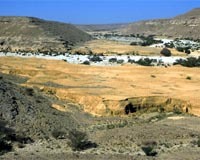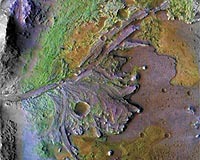
|
| ©SPX File Photo |
| Southern Yemen. |
As part of a larger program of archaeological research, Michael Harrower from the University of Toronto and The Roots of Agriculture in Southern Arabia (RASA) team explored the Wadi Sana watershed documenting 174 ancient irrigation structures, modeled topography and hydrology, and interviewed contemporary camel and goat herders and irrigation farmers.
"Agriculture in Yemen appeared relatively late in comparison with other areas of the Middle East, where farming first developed near the end of the last ice age about 12,000 years ago," says author Michael Harrower, Department of Anthropology, University of Toronto.
"It's clear early farmers in Yemen faced unique environmental and social opportunities and challenges. Our findings show farming in southern Yemen required runoff diversion technologies that were adapted to harness monsoon (summer) runoff from the rugged terrain along with new understandings of social landscapes and rights to scarce water resources."






Comment: It's unfortunate that the authors didn't think to include - maybe because of the very effect under discussion - a far more crucial example: the destructive effect of pathological deviants in our society.